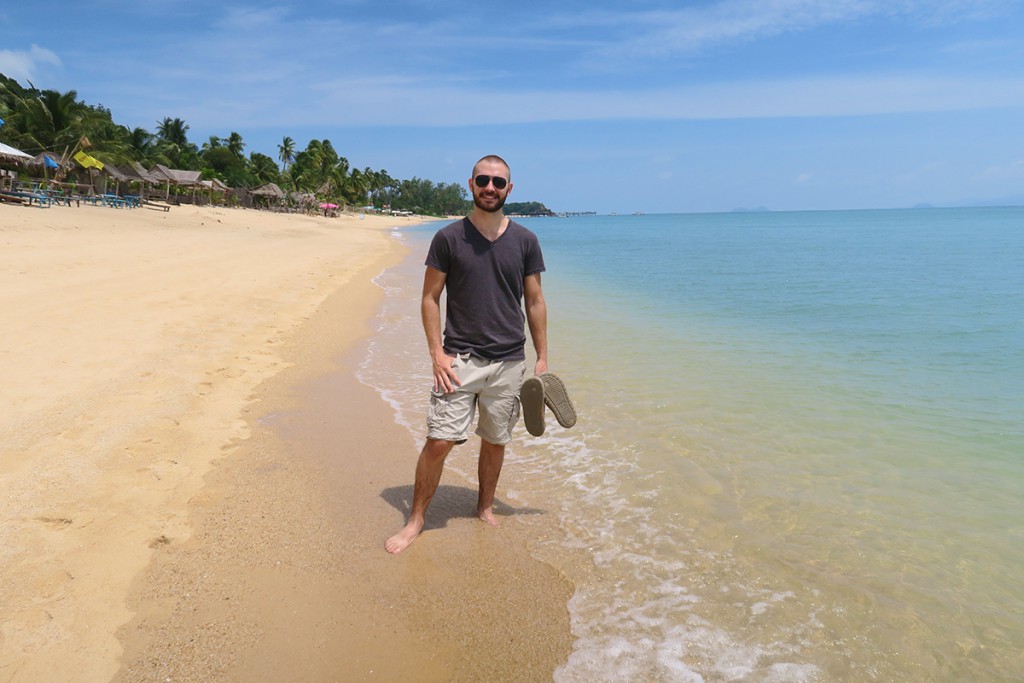Amy and I spend around nine months per year traveling the world and crossing items off of our bucket lists. At any given time, you may find us: learning salsa in South America, sailing Ngalawas off the coast of Mozambique, racing auto-rickshaws through the bowels of India, or just soaking up some sunshine in Thailand. For us, however, the “professional vagabond” lifestyle isn’t about spending every waking moment on the road. It’s about having options; the freedom to choose how and where we spend our time. It just so happens that, more often than not, we choose to spend our time doing interesting things abroad.
Let’s be honest, for most of us the idea of perpetual travel is somewhat far fetched. It’s fun to think about, but in reality, it is often written off as little more than a pipedream. This is exactly how I thought about the professional vagabond lifestyle before I started to live it. I believed that I needed to make my fortune while I was young and able.Then I would have time to then enjoy it all when I was old and probably decrepit. Fortunately, I found out that it was possible to do both at the same time (Phew!). I don’t know about you, but I’d prefer to enjoy my adventures without the constant worry of dislocating my hip.
In reality, my wife and I aren’t unique. Millions of ordinary people enjoy this lifestyle simply because they took the time to figure out how to finance it. Once you know that it’s possible, financing full-time travel is simple enough. The hardest part is making a firm decision to go for it.
A Simple Goal
Before we discuss the financing strategies themselves, let’s define the goal a little more clearly. For the purpose of this article, I’m going to assume that you want to gain the freedom to see and experience the world on a full-time or near full-time basis. If this is your goal, then you needn’t worry yourself with things like becoming a millionaire or even increasing your income.
If you live in the first world, you’ll probably find that you can experience most countries for far less than it costs you to live in your hometown. For example, you can live like a king in Thailand on the equivalent of minimum wage in the US or the UK. The goal, therefore, is not to become rich. It’s simply to detach your income from your physical location. In an ideal world, you’d also detach your income from your direct involvement, as well, though this isn’t necessary.
Below are five strategies that you can use to achieve these goals. If you read them with a proactive mindset, the chances are high that you’ll find at least one that excites you. Before you settle on a course of action, be sure to read through all of the options. I’ve saved the best for last.
Important: The suggested resources below are provided for your benefit only. We do not have a relationship with any of the recommended websites.
#1. Freelancing

A freelancer is a person who sells services to customers on a contract basis, rather than working as an employee of a single company. If you have a skill such as: creative writing, translating, graphic design, bookkeeping, computer programming, social media management, or online marketing, then this may be a good option for you.
As a freelancer, you’ll be able to sell your services to a global client base, and work on projects irrespective of your physical location. Also, because you don’t work for a specific company, you have the freedom to set your working hours. This flexibility makes it easy to structure your work around your lifestyle, rather than the other way around.
Thanks to the Internet, becoming a freelancer has never been easier. Websites, such as Upwork.com, take a lot of the pain out of things like finding clients, issuing quotes, and collecting payment. There are also many books and courses available online that will show you exactly how to get started.
Getting Started
Books:
Courses:
Portals:
#2. Remote Employment

Remote employment differs from freelancing in that you continue to work as an employee of a single company. The idea is to establish a remote working agreement with your employer whereby you continue to perform your responsibilities but from a location of your choice. This approach gives you a degree of financial stability without being bound to a single physical location.
Timm Ferriss was the first to make remote employment a popular option, in his book, “The 4-Hour Workweek.” Since then, thousands of people around the world have successfully implemented this strategy. Technology makes it possible to perform most jobs from any physical location (just ask any freelancer). The biggest challenge you face is to convince your employer that, in addition to being possible, it is also beneficial to the company.
I know, I know, your boss would never agree to this, right? If this option feels like a good, albeit totally unrealistic fit, then I recommend looking into it further before writing it off completely. Others have done it before you; you just need to find out how.
Getting Started
Books:
#3. Moving Employment

Moving employment involves finding a new job that, by it’s very nature, necessitates travel. A good example of this is working on a cruise liner. Cruise ships require a variety of skilled and unskilled staff including: photographers, entertainers, personal trainers, massage therapists, casino dealers, bartenders, and more. Here you’ll get to travel the world on a floating resort while enjoying free food and accommodation.
Another good example of moving employment is working on yachts or superyachts. Before writing this section, I spoke to a friend of mine who has done this for several years. In his opinion, working on a yacht is one of the best ways to see the world. He did caution me, however, that anyone looking to follow this route needs to be willing to put in some hard work. With a small team, everyone onboard is required to pull their weight, often literally.
While the above examples are the most popular, there are many similar job and volunteer opportunities out there. Take some time to do your homework and find a position that suits your desired lifestyle.
Getting Started:
Cruise ship jobs:
Yacht jobs:
#4. Travel Blogging

Travel blogging isn’t the easiest option, but in the long run, it’s one of the best. The idea is simple enough: you travel around the world and write about your adventures. As you do this, you build a database of subscribers and social media followers. Once you have a responsive following, it isn’t difficult to monetize it by selling products, advertising space, etc. If you play your cards right, you may even be able to convince companies to sponsor your trips.
One of the best things about travel blogging is that, unlike the options listed above, it will ultimately build momentum. As you create a body of high-quality content and grow a list of responsive followers, you’ll start to earn income that is disproportionate to your daily effort. In other words, it requires the same effort to run a blog with 100 000 subscribers as it does to run a blog with 100 subscribers.
Unfortunately, its biggest strength is also its biggest weakness. You don’t start with any momentum. This means that you’ll have to invest a lot of energy in the early stages of your blog with little to no reward. If you feel that this is the option for you, I recommend starting with a more immediate strategy, such as freelancing, while you build your blog on the side.
Getting Started
Books:
Courses:
#5: eCommerce Blogging

When I talk about “eCommerce,” I’m referring to a website that sells physical or downloadable products to a specific group of people. My first eCommerce business, for example, sold cycling safety products to avid cyclists. We advertised our products using Facebook, customers bought them on our website, and our system automatically delivered them to the customer’s inbox or address.
I decided to go this route for two primary reasons:
First, while the business does build momentum over time, it’s possible to generate substantial profit almost immediately. BuyCycleSafety.com is a prime example of this. The business went from a cold start to generating around $1 000 per day within six weeks.
Second, and most important, an eCommerce business can be automated. Once your website and ads are running, they don’t need constant supervision. On average, it takes me less than two hours per week to manage a profitable eCommerce website.
Getting Started
In my opinion, starting an eCommerce business is the easiest option on this list. To help you get started, I’ve created a couple of free resources:
Just Do It!
Tomorrow becomes never. No matter how small the task, take the first step now! Tim Ferriss, The 4-Hour Workweek
The most difficult step is always the first one because it requires a decision. I encourage you to take the first step right now. Choose a path, do some research, and see where that takes you. You never know; it may take you further than you ever thought possible.






Hi Ryan,
Thank you for your kindness in sharing this info!
Thanks!
I love a lot what you promote, it inspires me and I am glad such people like you exist!!!
I read with interest your articles and one of those caught my attention: “5 ways to finance full-time travel”. I would like to make an addition, with your agree of course; these 5 ways to finance can be completed with the sixth way in fact: the one within to be part of an amazing community of people who wish to travel, to share their experiences, to have fun, to become free and fulfilled…
I am proud to be member of this million people community all over the world and I would like to share you more about; there is a chance to start together helping others – travelling more and seeing their dreams coming true -.
I look forward to hear from you the way to get in touch directly: Skype or other private option.
Thank you a lot for what you do!
Hola Ryan !
I found your story today!
Here Sebastian from Argentina.
Thank your for sharing your experience with the global community. I’m reading all your publications and going through every step, as well downloading the guides. My aim is to become free from local económic ups&downs (more downish lately jaj) . After choosing the niche market that fullfils my spirit, I’ll start with creating the webpage. Do you recommend Wix for e-commerce DIY webpages, in order to link it to Paypal and develop an automated reply-logistics system ?
Thanks again
Sebastian
Interesting read with a lot of good ideas.
We’ve been travelling / blogging as we go for 18months. My missus puts in a lot of hours on the laptop.
People always ask how we manage it or how we saved enough money.
As long as you lead a modest life & aren’t interested in £2k Prada handbags, saving is easy and money goes A LOT further than trying to live a normal life wherever “home” is.
We got married on the road, instead of blowing 20-30k on a wedding we’ve spent it having a year long celebration together.
The thing that really restricts people from travelling is themselves.
People’s priorities are the only restriction.
I’m one half of twoscotsabroad if your interested
I like your site. Safe travels
Dear Ryan
As it is I just resigned from my work that I have been involved with for 8 years and working for full time 4uears . I just got to that point that I just turned 30 and I have not reached my goal. Have been unhappy living pay cheque to pay cheque from the start and getting comments that R13000 is so much money bur paying the bills it is not even enough. How do I get started I have never build my own website and how does the payment system work and integrated with your system. How do you get suppliers to give you their products?Sorry for all the questions. Being without work stress getting to me. Regards from Pretoria South Africa
Hi, Louise Barnard here!
Thanks so much for this article, I found really interesting and helpful. I am wanting to travel to London for a few months next year, ( South African resident ) also to expand my knowledge and horisons in terms of digital marketing and online retail. I am really interested in how you managed to set up the packaging and distribution of the products from your website, and manage the oversight of the business whilst traveling? I know this is possible (clearly you doing it… ) what I need to know is how you did it! I would be so grateful for the help!! I currently want to move my business ( retail store and online ) to a complete online business, and travel and attend seminars on how to expand my network of passive income. Could you perhaps give some suggestions! Loved the story of you guys taking the plunge, I have owned the business nearly 5 years, know all about the stress!!!
Thanks for sharing,
Louise
Hi, Louise!
Thank you for the encouraging words 🙂 I’m glad that you found our story and suggestions helpful.
Have you downloaded my case study, yet? In it, I cover my whole distribution setup in detail. The process is a bit too involved to describe in the comments section, unfortunately.
I recommend reading through the case study, and then emailing me specific questions. I’ll send you my personal email address when you download the study.
I work for a small local business, due to the nature of my work I can pretty much work anywhere so long as I have a phone and access to the Internet….which makes me a prime candidate for remote employment. How on earth though do I go about convincing the director that this is a good idea?!
Hi, Louise.
I plan to write an entire post on this topic shortly. In the meantime, I recommend reading “The Four-Hour Workweek” by Tim Ferriss. He gives a lot of great tips in there!
The short answer to your question is that you should do it slowly. Start by calling in with a crisis every now and again and ask to work from home. Once you’ve worked from home a couple of times, meet with the director and report increased productivity in these instances. Ask to work from home once per week for a month as a trial.
Keep producing good results from home and try to extend the trial. If you can prove that you’re more valuable from home, you should be able to free yourself completely over time.
I hope that this helps!
Great article Ryan! I’m working towards a life on the road myself and your links will be very helpful!
Thanks, Kieran! Which method are you planning to use?